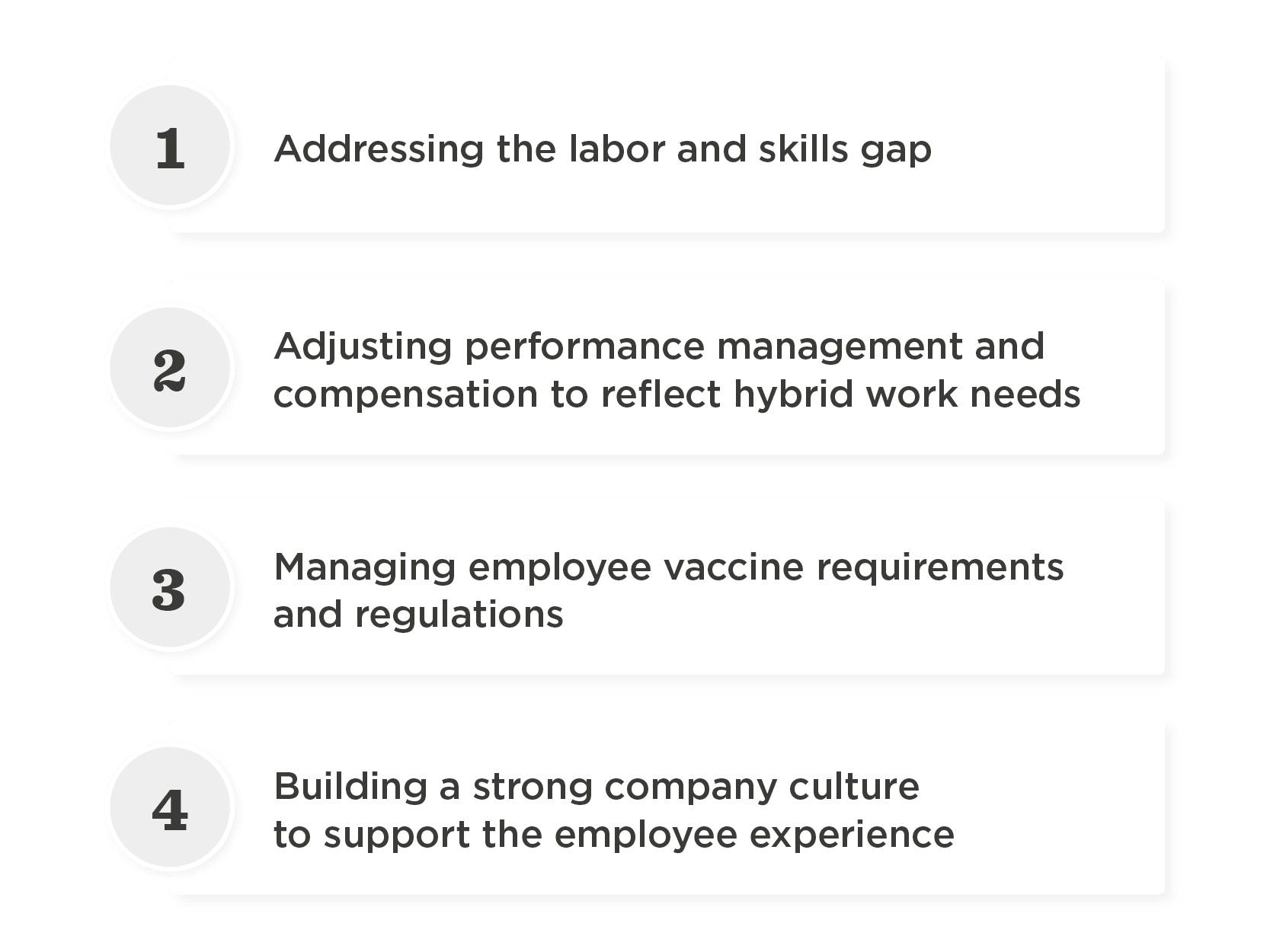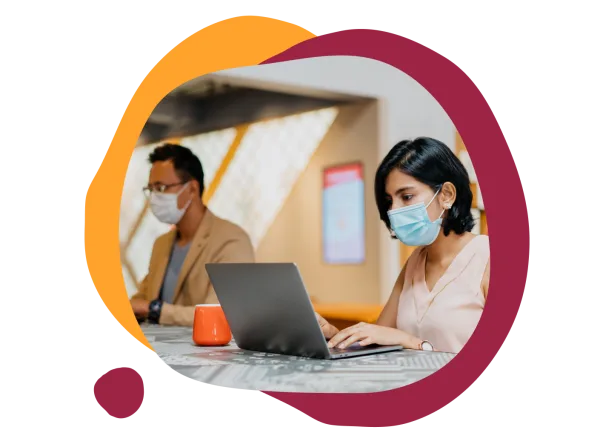The COVID pandemic put a spin on every aspect of our existence. As caretakers of all things employment-related, HR professionals now have to navigate not only the spin created in their own lives but also the pandemic experiences of their organizations.
“I didn’t need COVID to appreciate the importance of the HR professional,” Albert Bourla, CEO of Pfizer Inc., told the Society for Human Resource Management. “HR is one of the most critical functions in a corporation, and I’ve always believed that.”
While Bourla may have valued HR and seen the importance of people ops before the COVID era, that hasn’t been the case in every organization. HR professionals were often the last ones called on in executive meetings and placed at the end of the agenda.
That quickly changed when companies had to shut their doors in response to the pandemic. Companies changed their views to see HR leaders as essential, influential contributors. After all, their strategic insights and innovations allow businesses to stay afloat in today’s tumultuous times.
“The COVID-19 pandemic has elevated the importance of HR professionals within organizations as never before. HR practitioners no longer need to convince business leaders to consult with them on key decisions. Those leaders are now coming to them, often on a daily basis,” according to the Society for Human Resource Management (SHRM).
HR has always been important, but as the world of work evolves after the pandemic, HR has an opportunity to define and develop an approach that ensures an organization’s workforce is engaged. The pandemic has not changed HR’s core priorities: recruiting, hiring, developing, and managing an organization’s people. However, due to the impact and fallout from the pandemic, the immediate focus for HR is in four primary areas:

In this guide, we’ll cover each of these priorities and offer insights into how your HR team can address them as we navigate new waves of COVID and head into a post-pandemic world.
Addressing the labor and skills gap
Whether because of pandemic fears or new outlooks on what’s important, people aren’t jumping to fill open jobs. Although employers are starting to return to operational models that resemble the pre-pandemic work environment, their employees aren’t returning to the worksite with them. Adapting to the new way of work is critical for organizations to establish a labor force and resilient operational model.
“A recent survey of business economists conducted by the National Association for Business Economics revealed that labor constraints aren’t likely to go away any time soon. Only six percent of respondents expect[ed] labor shortages to diminish by the end of 2021,” according to reports from SHRM.
Add the skills shortage to the labor gap, and employers really feel the crunch of empty workstations. Seventy-four percent of organizations agree that reskilling their workforce is vital to their success over the next 12–18 months. However, according to Deloitte, only 10 percent say they’re ready to tackle the challenge.
“Successfully understanding the needs of the organization, mapping needs to employee goals, and improving business performance through reskilling is no easy feat,” according to Training Magazine.
To find the talent to address the skills shortage, SHRM suggests that organizations find innovative ways to recruit talent from various labor pools, train people, and partner with educational institutions.
2 ways to address the labor and skills gap
1. Offer internships as a way to find skilled talent
“The most straightforward reason for having an internship program is to create a new crop of employees for a company’s specific business needs. Internships can act as a trial run for employers and interns to discern whether they’re a good fit,” according to SHRM.
If you don’t have an internship program, look at what it would take to develop one. If there are roles that are constantly open, start there. Not only will you find temporary help in the critical areas, you’ll have a potential pool of talent you can source from for permanent hires.
2. Identify missing skills and address them with on-the-job training and resources
Even if people don’t have the skills they need, it doesn’t mean they don’t want to improve and gain new ones. One survey found 45 percent would stay at a job longer if employers offered skills training.
If you want to address the skills gap, make sure you clearly define job responsibilities. Then, ensure that your learning management system has appropriate training content people can use to develop the hard and soft skills required in their current and future roles.
To upskill people, you need to make training easily accessible. This training should be available 24/7 and on any device. Keep track of the training people complete via your learning management system to have the data you need about which people have which skills.
Once organizations have the skilled labor they need, they must manage performance and compensation to entice and encourage talent to stay.
Recommended For Further Reading
Adjusting performance management and compensation to reflect hybrid work needs
When work environments became remote during the pandemic, the familiar lunchroom and water cooler conversations became obsolete. The ability to have a drop-by conversation with a leader also became next to impossible without some pre-planning. Overnight, the model for performance management shifted from following up in person to finding time to connect virtually. The pandemic forced organizations to adopt modern performance management practices and deliver them via a virtual model to inspire performance. The fundamentals have remained the same, but they’re evolving towards a data-driven, flexible approach that emphasizes development.
In addition to changes in managing performance with a remote workforce, some employers chose to shift their compensation models. One survey of senior managers found that 57 percent of senior managers said their company “suspended salary increases” due to the pandemic. The Conference Board predicts that US salary increase budgets across all categories (hourly, salaried, executive) for 2022 is 3 percent. That’s the same average it’s been for the past 10 years.
As we explain in this HiBob guide, a complete compensation plan includes several key elements. It’s more than your total pay package. You also need a compensation philosophy and a plan alongside a consistent plan evaluation. During this time of transition, it’s essential to review and adjust your performance management and compensation plans. Your company will be better off for it, and people will appreciate your recognition of the changing times.

2 ways to address performance and compensation management
1. Inspire performance with data, analytics, and an emphasis on team
McKinsey identified a few key practices for performance conversations in the pandemic era. Those practices include using people analytics to access personalized, real-time data to inform performance feedback. Even after the pandemic ends, McKinsey also sees a “stronger emphasis on team, rather than individual, performance as processes and deliverables increasingly depend on cross-functional cooperation.”
Despite the pandemic, the fundamentals of performance management remain the same. However, due to the new parameters of remote and hybrid work, how performance management occurs is evolving—organizations must adapt and modify their approach accordingly by using people analytics and focusing on team deliverables.
2. Assess compensation based on a hybrid workforce and pay equity
As organizations shift to hybrid work, the CEO and co-founder of OpenComp recommends considering the pay differences by geography and levels, examining the potential of establishing policies across the organization and regions, and ensuring equitable pay and promotions for people working on-site and remotely.
You can also compare jobs against three categories: a) difficult to fill jobs, b) high turnover, and c) need to achieve results. Based on your review of these categories, assess where your compensation spend will be.
Performance management and compensation are key to employee engagement. But those elements don’t just impact the individual employee experience. With the right programs in place, your performance and compensation approach help build the foundation for a strong company culture.
Managing employee vaccine requirements and regulations
Whether you’re located in a state that’s issued its own emergency temporary standard (ETS) or not, it’s critical that your organization is prepared to comply with new laws and mandates as they arise to minimize the risk of COVID-19 transmission in the workplace.
The responsibility for ensuring that people have either been vaccinated or have tested negative for COVID before coming to work falls on the company’s shoulders, and more specifically, on HR. It can be overwhelming. Sending emails to hundreds of employees asking for vaccination cards or negative COVID tests and keeping track using spreadsheets is impractical and unsustainable, not to mention insecure.
Your HRIS, as the central source of information on your people, is the natural place to store information on their vaccination status. Make sure you have a flexible HR platform that not only gives you the security you need to keep your people’s data completely confidential but is also configurable and flexible to support any future requirements.
The first step to following the ETS is creating a record of who is and isn’t vaccinated at your organization. HR leaders, managers, and employees can use Bob to easily and securely collect, record, track, and update people’s COVID-19 vaccination statuses across sites.
People can simply update their vaccination status and upload their vaccination documents straight to their employee profiles. HR leaders and managers can view the status in dashboards and graphs, and produce reports for regulations and compliance. This makes it easy to create a safe and compliant workspace for everyone.
Building a strong company culture to support the employee experience
Company culture was important before the pandemic, but now as organizations navigate a transition to new operational models—including hybrid and fully remote—what worked in the past may need to be modified.
A recent Return to Workplace survey by Deloitte revealed that “the number one concern of business leaders is maintaining company culture in a post-pandemic world. With many people no longer meeting in person or having limited opportunities to interact, there are worries that company cultures could erode. It’s a critical point to address, especially for growth-oriented leaders.”
In response to the shift into this new normal, many organizations are adapting their methods of communication and redesigning their approach to employee experience.
“[The pandemic] has altered what we emphasize; for example, we’ve long been committed to continuously developing our culture and communication strategy. Direct, transparent, ongoing communication anchors trust in leadership’s relationship with our employees. The pandemic has solidified our commitment to refining and streamlining our communication strategy,” PMI Chief People Officer Tammy Perkins told HR Executive.
In addition to seeking out remote and hybrid work options, people today are also looking for organizations that best match their personal values. Organizations that connect on a cultural and values-based level with people will position themselves to attract and keep the talent they need to continue growing.

2 ways to address company culture
1. Be intentional about managing attrition risks
According to headlines since the pandemic began, many people have started looking for new roles. It can be hard for HR teams worried about attrition to know who’s thinking of leaving. That’s why Bob’s Core HR package includes an Attrition Indicator. It gives managers a holistic view of their people and their risk of attrition, alerting them to steps to retain them. Retention could be as simple as making time for a conversation to ask how they’re feeling about work or by offering incentives, such as a salary increase or promotion.
2. Ask people for feedback about the culture and their current experience
Even if you had a strong culture before the pandemic, things might have changed. It’s important to at least get a pulse on how people feel. Start by sending a survey to gather data about the employee experience, productivity, and retention throughout the pandemic. If you don’t have a people analytics tool yet, you can use tools like Google docs or Microsoft Excel to collect your data.
Give people an opportunity to share what they want the company culture to look like now and after the pandemic ends: What would make them happier at work? Are there different ways of communicating they’d like to see? Now that your model has changed, do they want other kinds of benefits or team activities? Ask them about any culture shifts they’ve seen—are things better, worse, or the same?
The pandemic normalized hybrid work, flexibility, and a commitment to transparency for many organizations. Most importantly, organizations can use these new norms to revitalize their cultures. By prioritizing a human-centered approach, organizations can evolve their culture to one where everyone continues to thrive.
Conclusion
As we look back, 2020 is the dividing line between the “old normal” and the “new normal.” The work world we knew before COVID, and the world we’re building now, are totally different. In just two years, everything has changed.
“Organizations have by and large met the challenges of this crisis moment,” according to McKinsey. “But as we move toward imagining a post-pandemic era, a management system based on old rules—a hierarchy that solves for uniformity, bureaucracy, and control—will no longer be effective.”
People have been talking about the “future of work” for a while. The pandemic brought that future to the collective HR doorstep and helped modern HR professionals earn their seats at the table. Today, businesses consider HR leaders critical stakeholders who demonstrate the impact of HR and people strategies.
HR’s flexibility and responsiveness during the pandemic made it apparent how they must proceed in the future. This is the time for HR to build upon what they and their organizations have learned and deliver people-centered strategies.
Today’s world of modern HR leadership must adapt and evolve how it addresses the labor gap, performance and compensation management, and company culture. If HR professionals’ adaptability and creativity during the pandemic is any indication, they’re more ready than ever to establish employment practices that bring people to the forefront of the organization.
Meet Bob
At HiBob, we’ve built a modern HR platform designed for modern business needs—today and beyond.
We focused on building something robust yet intuitive and easy to use, which has led Bob to be the platform of choice for thousands of fast-growing modern, mid-sized organizations.
For HR, it automates many common processes, allows greater oversight and visibility of the business, and centralizes all people data in a secure, user-friendly environment.
For managers, it provides access to data and insights to help them lead more effectively and streamline processes.
For employees, it’s the tools and information they need to connect, develop, and grow throughout their journey.
In a short time, Bob can be deployed to enable communication, collaboration, and connectivity that drives stronger engagement, productivity, and business outcomes.
